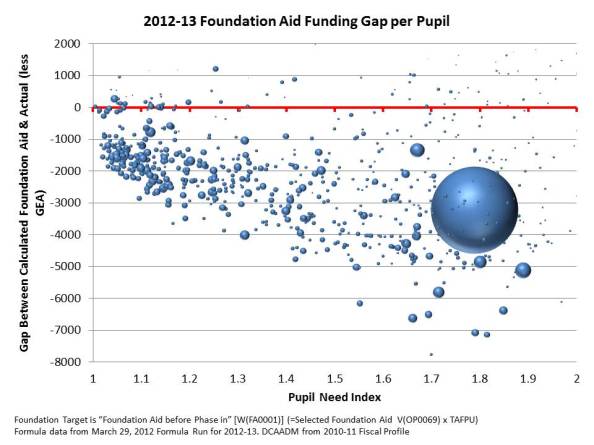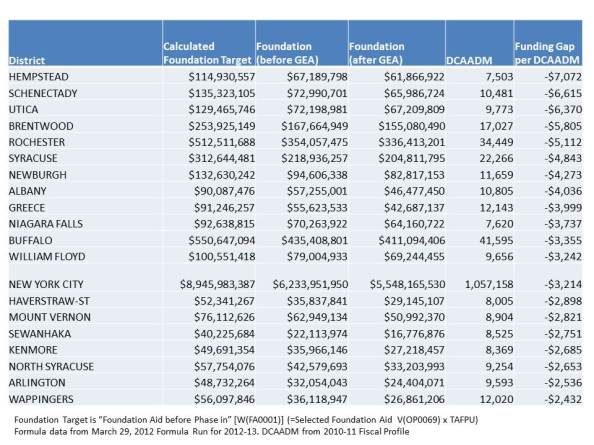Data and thoughts on public and private school funding in the U.S.
Forget the $300m Deal! Let’s talk $3.4 billion (or more)!
Posted on December 7, 2012
Sometime last week or so, Sockpuppets for Ed Reform marched on City Hall in NY demanding that the city and teachers union come to a deal on a teacher evaluation system compliant with the state’s new regulations for such systems, so that the district could receive an approximately $300 million grant payment associated with the implementation of that system. Well, actually, it was more about trying to enrage the public that the evil teachers union in particular was at fault for holding hostage and potentially losing this supposedly massive sum of funding.
As one can see by the signs the SFER protesters were displaying, the protest was much less clearly articulated than I’ve described above. On would think, from looking at stuff like this: http://nyulocal.com/wp-content/uploads/2012/11/DSC_0841.jpg that this protest was actually about obtaining funding for the district – funding that would provide for substantive and sustained improvement to district programs/services.
But hey, far be it for SFER to actually carry placards that are in any way accurate or precise (or to have any clue what they are talking about). At this particular event in NYC, they even convinced a 15 year old that the fight was really about funding.
So, we’ve got a protest that is presented as being about funding, but is really about a teacher evaluation system driven by student test scores, being carried out by a group that clearly has little or no understanding of either.
You know, I would typically give a group of undergrads a break on stuff like this. Hey, they’re undergrads and have time to learn/develop the discipline/understanding of these complex topics. Heck, I was anything but a disciplined undergrad myself. But unfortunately, this group has thus far displayed to me the worst attributes of the most intellectually lazy of today’s college students – a persistent pattern of copying and pasting low quality content from web sites and presenting it as novel content of their own. It’s as if their placards, and their entire website was generated by lifting content from “reformy-pedia.”
So then, what is the real story on what’s goin’ on with Teacher Evaluation and School Funding in New York State?
The State Evaluation System/Guidelines
I’ve written several posts recently about the state metrics for teacher evaluation and the state department of education push to get districts on board. I also wrote about the letter from the Chancellor of the Board of Regents which appeared in the NY Post, encouraging NYC in particular to get on board with that $300m RAW deal!
In my humble opinion, no-one should sign on to a deal to implement a teacher evaluation system under the current NYSED guidelines, given the evidence I’ve laid out over the past few weeks. No-one. Just say NO.
First, the state’s consultants designing their teacher and principal effectiveness measures find that those measures are substantively biased:
Despite the model conditioning on prior year test scores, schools and teachers with students who had higher prior year test scores, on average, had higher MGPs. Teachers of classes with higher percentages of economically disadvantaged students had lower MGPs. (p. 1) http://schoolfinance101.files.wordpress.com/2012/11/growth-model-11-12-air-technical-report.pdfBut instead of questioning their own measures, they decide to give them their blessing and pass them along to the state as being “fair and accurate.”
The model selected to estimate growth scores for New York State provides a fair and accurate method for estimating individual teacher and principal effectiveness based on specific regulatory requirements for a “growth model” in the 2011-2012 school year. p. 40 http://schoolfinance101.files.wordpress.com/2012/11/growth-model-11-12-air-technical-report.pdfThe next step was for the Chancellor to take this misinformation and polish it up as pure spin as part of the power play against the teachers in New York City (who’ve already had the opportunity to scrutinize what is arguably a better but still substantially flawed set of metrics). The Chancellor proclaimed:
The student-growth scores provided by the state for teacher evaluations are adjusted for factors such as students who are English Language Learners, students with disabilities and students living in poverty. When used right, growth data from student assessments provide an objective measurement of student achievement and, by extension, teacher performance. http://www.nypost.com/p/news/opinion/opedcolumnists/for_nyc_students_move_on_evaluations_EZVY4h9ddpxQSGz3oBWf0MThen send in the enforcers…. This statement came from a letter sent to a district that did decide to play ball with the state on the teacher evaluation regulations. The state responded that… sure… you can adopt the system of multiple measures you propose – BUT ONLY AS LONG AS ALL OF THOSE OTHER MEASURES ARE SUFFICIENTLY CORRELATED WITH OUR BIASED MEASURES… AND ONLY AS LONG AS AT LEAST SOMEONE GETS A BAD RATING.
The department will be analyzing data supplied by districts, BOCES and/or schools and may order a corrective action plan if there are unacceptably low correlation results between the student growth subcomponent and any other measure of teacher and principal effectiveness… http://schoolfinance101.wordpress.com/2012/12/05/its-time-to-just-say-no-more-thoughts-on-the-ny-state-tchr-eval-system/This is a raw deal, whether attached to what appears to be a pretty big bribe or not. And quite honestly, while $300 million is nothing to sneeze at, it pales in comparison to what the city schools are actually owed under the state’s own proposal for how it would fund its schools to comply with a court order of nearly a decade ago.
THE REAL ISSUE in NY State
Meanwhile, at the other end of the state – well sort of – a different protest was going on. This protest in Albany actually was about funding and the fact that the state of New York has repeatedly cut state aid from local public school districts each of the past few years, has systematically cut more per pupil funding from districts serving needier student populations and has never once come close to providing the funding levels that the state’s own funding formula suggest are needed (actually, were needed back in 2007!).
Here’s a quick run-down on the state of school funding in New York:
- New York continues to maintain one of the least equitable school finance systems in the country, where districts serving higher concentrations of children in poverty have systematically less state and local revenue per pupil.
- New York State accomplishes these patterns of egregious disparity not merely by lack of effort, but by actually allocating substantial state resources – disproportionate state resources – toward buying down the tax rates of the state’s wealthiest districts and making other politically convenient state aid allocations to economically advantaged districts, at the expense of children in poverty.
- Even though the state was ordered by the NY court of appeals nearly a decade ago to provide adequate resources to children attending high need districts, and even though the court accepted the state’s own proposed funding formula to meet that goal (which was much lower than more rigorously determined spending targets), the state has chosen to not even come close to funding those targets and in recent years has systematically cut more funding from children with greater needs.
But even that low-balled estimate of what districts were supposed to get has never been close to fully funded. Several large districts, including Albany, for example, receive in 2012-13, less than half of the state aid they are supposed to receive if the formula was implemented.
The formula provides a target level of funding for each district based on student needs and regional costs. Then, the formula determines the share of that target funding that should come from the state. Then, the formula as actually implemented, ignores all of that and provides a marginal increase or decrease (over what districts have historically received) maintaining the persistent inequities of the system.
The first figure below shows the difference between actual state foundation aid per pupil (after applying this trick they refer to as gap elimination adjustment) and the aid calculated to be needed according to THE STATE’S OWN FORMULA for addressing regional costs and student needs. Districts are organized from low need (left) to high need (right) using the state’s own pupil need index. Bubble size indicates district enrollment size. NYC is the BIG ONE! And, we can see, by eyeballing the middle of that bubble, that NYC is being shorted between $3,000 and $4,000 per pupil. At 1 million kids, that’s about $3.4 billion … each year… every year… over time. No, not a $300m implementation grant, but $3.4 billion in annual operating funds. Yeah… the stuff that actually provides for smaller class sizes, decent teacher pay, up to date materials, supplies and equipment, and arts, music and all that other stuff!

The table below provides a closer look at districts with the largest funding gap between what the formula calculates is needed and what districts actually receive in state aid.

So, instead of talking about a one shot $300m bribe to implement a bad system based on bad data, at a cost that may exceed the amount of grant to begin with, perhaps it would make more sense to focus on that $3.4 billion deal! You know, the one state officials themselves promised in response to that court order all those years ago.
And when we do start taking more seriously this much bigger funding issue, don’t forget to send me a cool lookin’ knit protest hat!
Readings
Policy Brief on State Aid in New York (Summer 2011) NY Aid Policy Brief_Fall2011_DRAFT6
Baker, B.D., Welner, K.G. (2012) Evidence and Rigor: Scrutinizing the Rhetorical Embrace of
Evidence-based Decision-making. Educational Researcher 41 (3) 98-101
Baker, B.D., Welner, K. (2011) School Finance and Courts: Does Reform Matter, and How Can We
Tell? Teachers College Record 113 (11) p. –
Baker, B.D., Corcoran, S.P.(2012) The Stealth Inequalities of School Funding: How Local Tax
Systems and State Aid Formulas Undermine Equality. Washington, DC. Center for American
Progress. http://www.americanprogress.org/wp-content/uploads/2012/09/StealthInequities.pdf
Baker, B.D., Sciarra, D., Farrie, D. (2012) Is School Funding Fair? Second Edition, June 2012.
http://schoolfundingfairness.org/National_Report_Card_2012.pdf
Baker, B.D. (2012) Revisiting the Age Old Question: Does Money Matter in Education. Shanker
Institute. http://www.shankerinstitute.org/images/doesmoneymatter_final.pdf
Baker, B.D., Welner, K.G. (2011) Productivity Research, the U.S. Department of Education, and
High-Quality Evidence. Boulder, CO: National Education Policy Center. Retrieved [date] from
http://nepc.colorado.edu/publication/productivity-research.
No comments:
Post a Comment